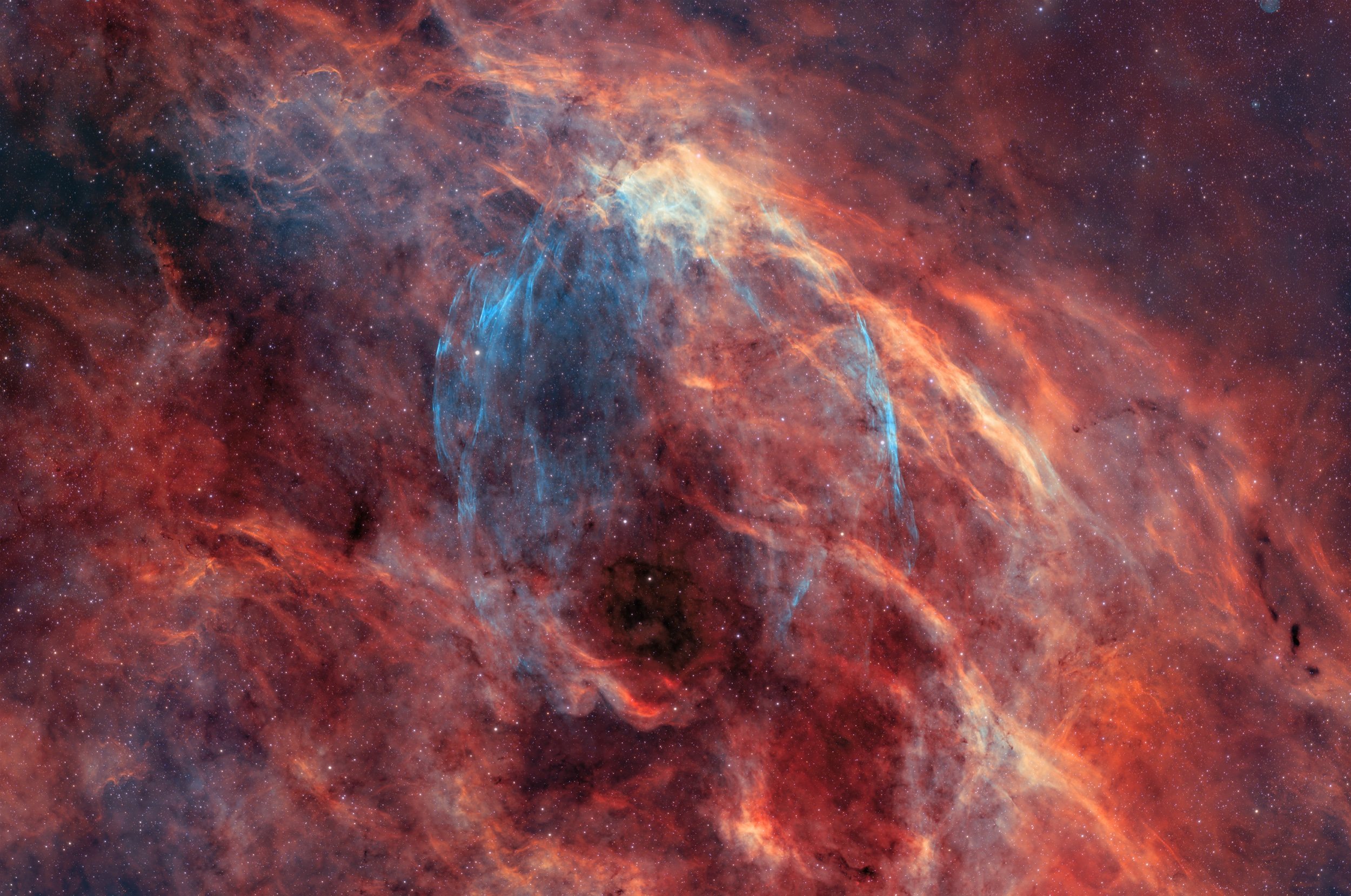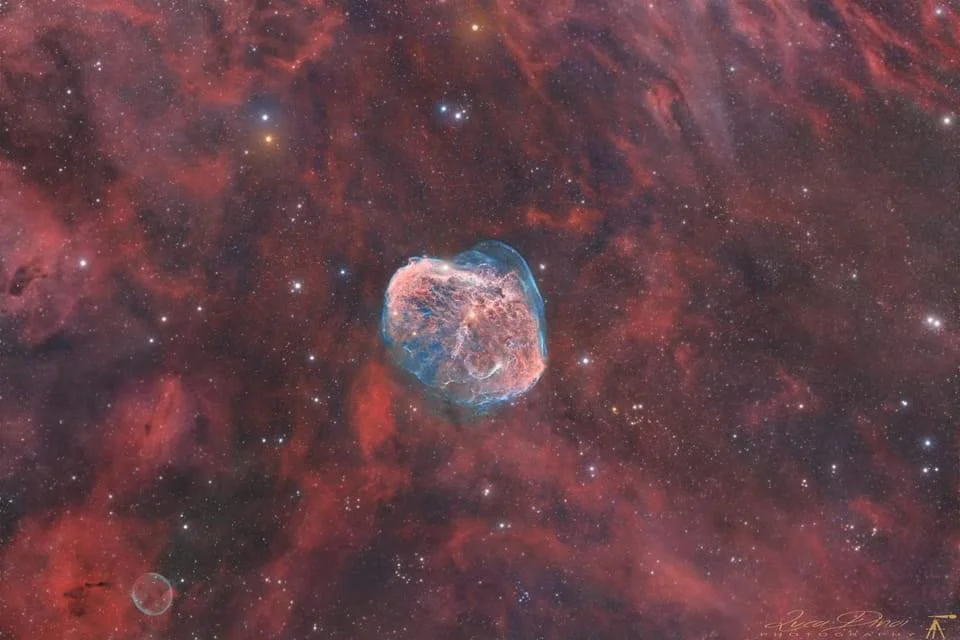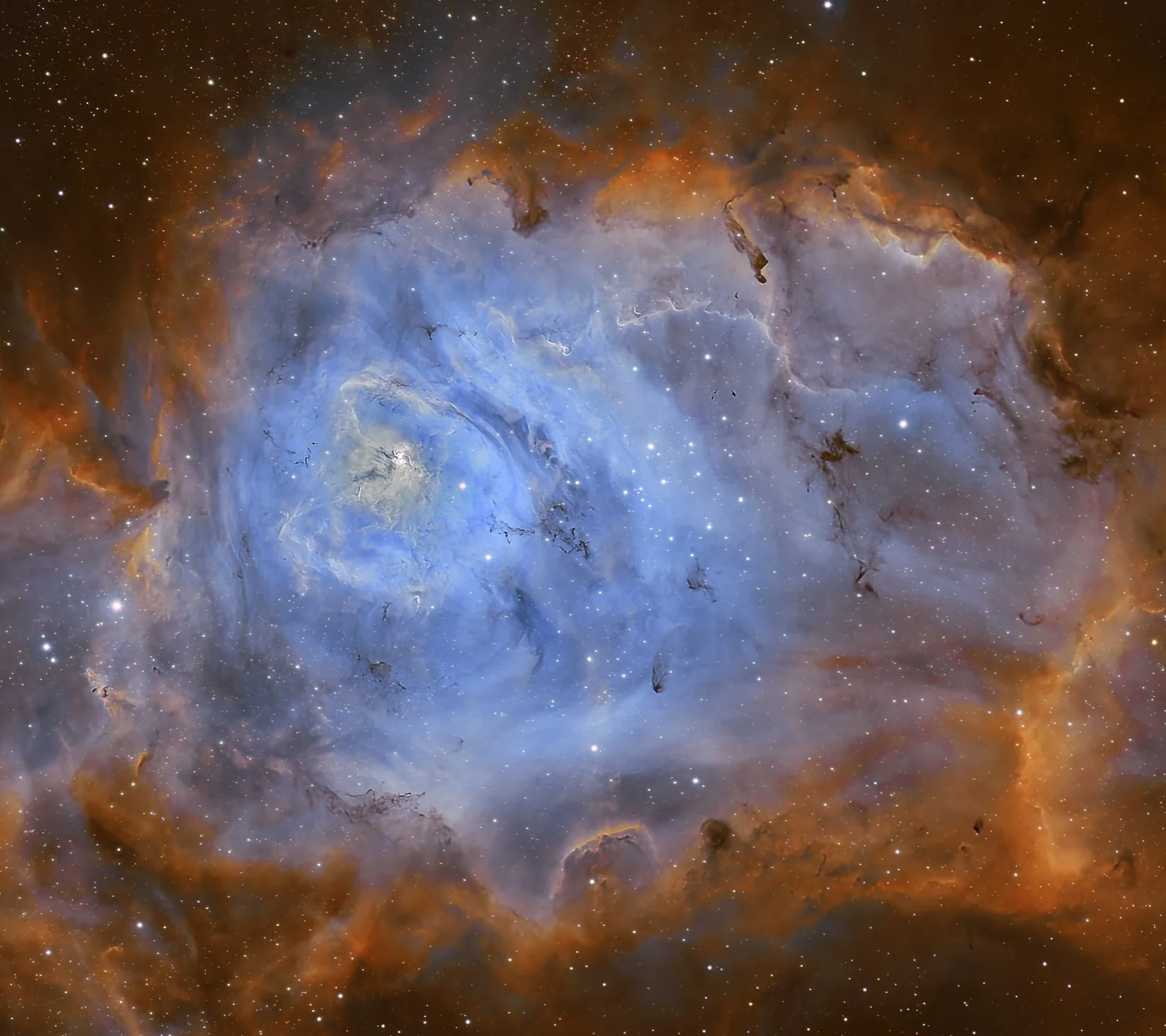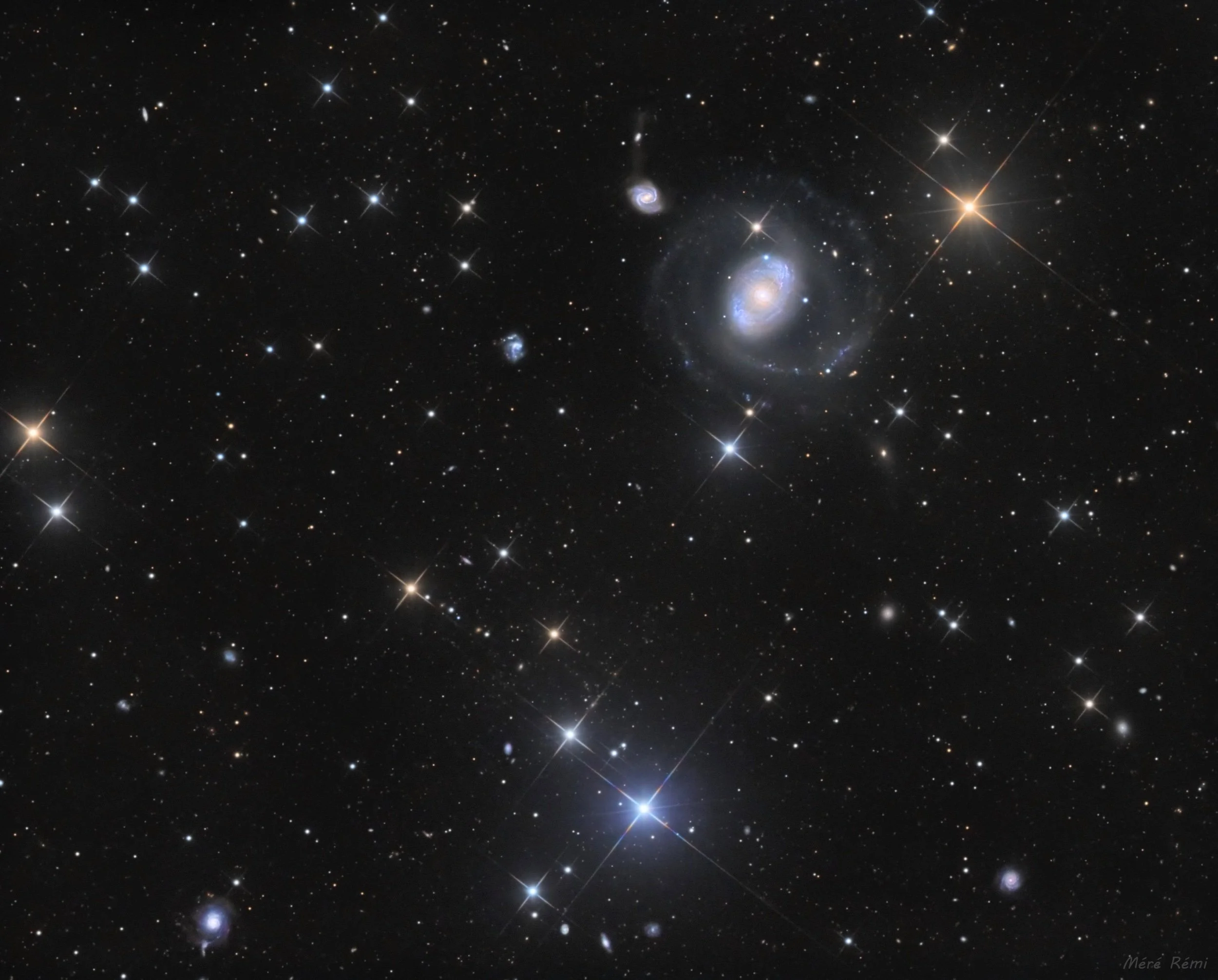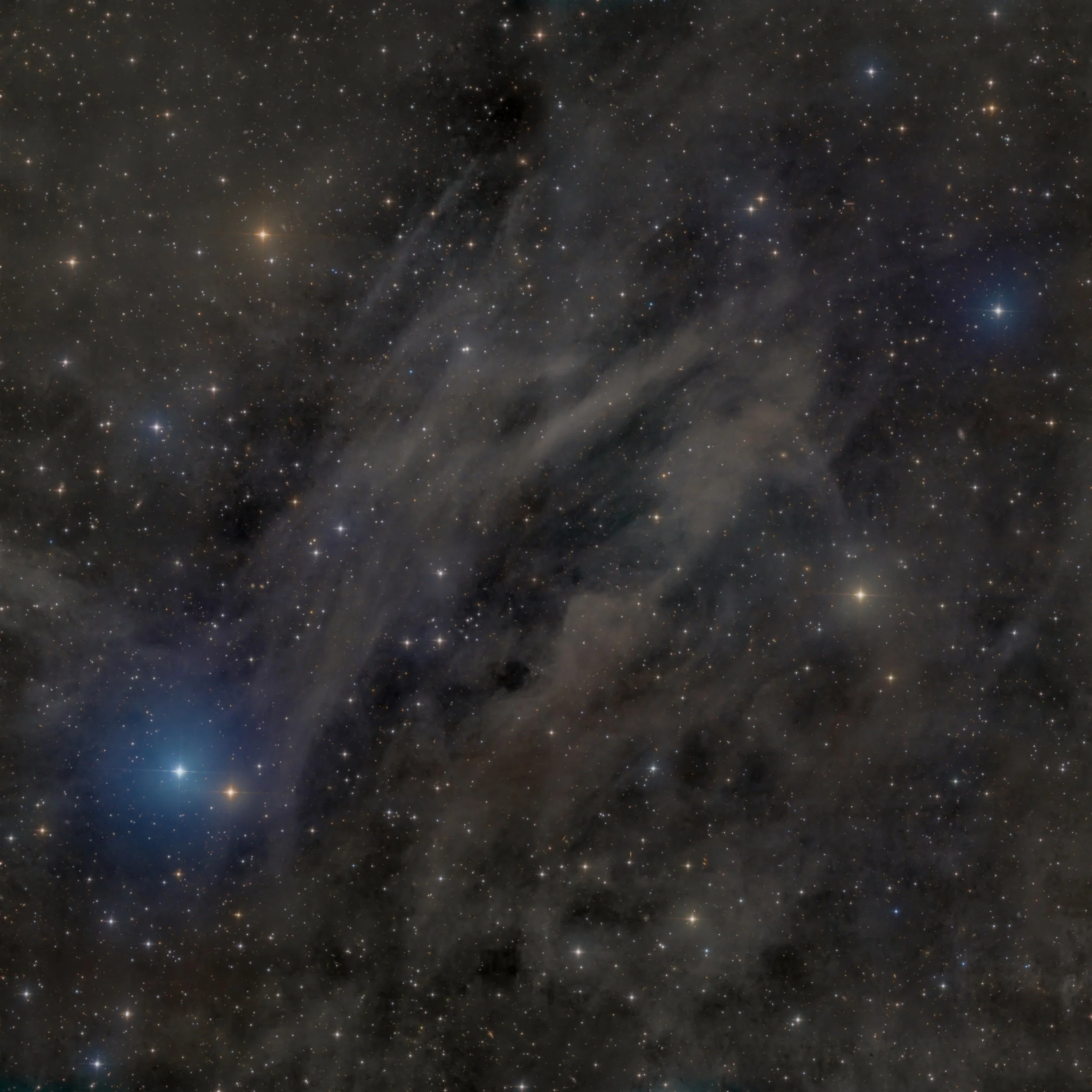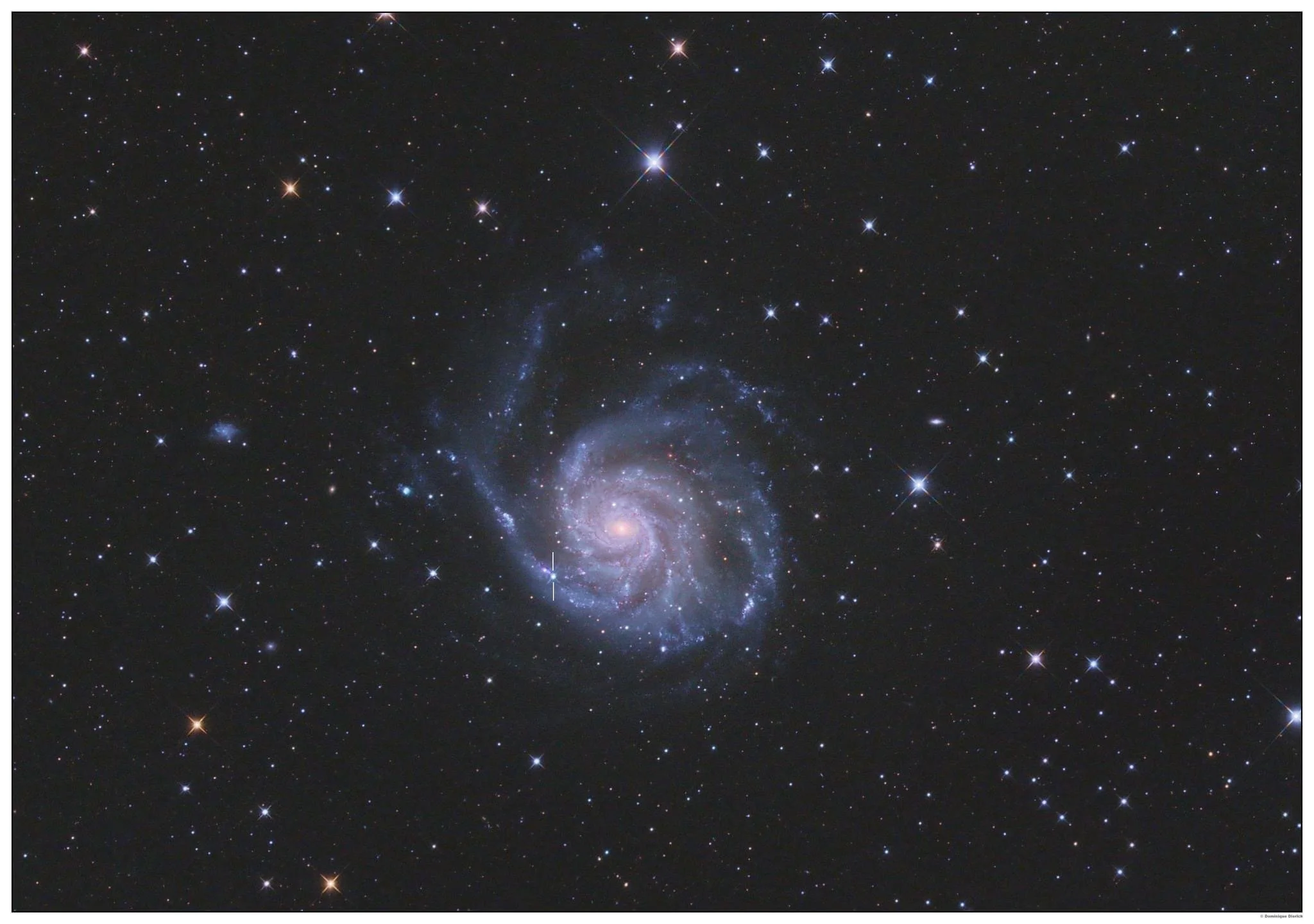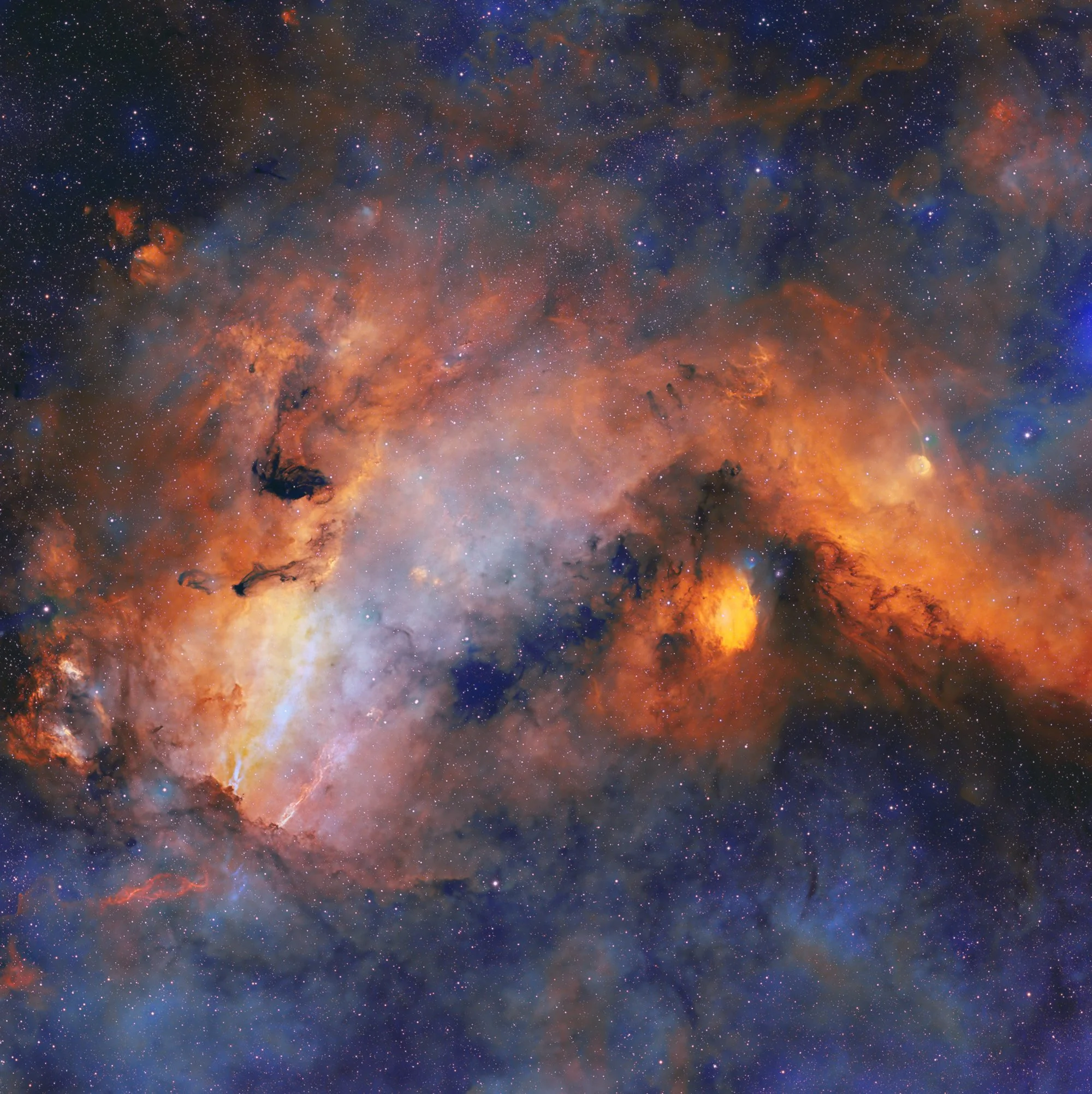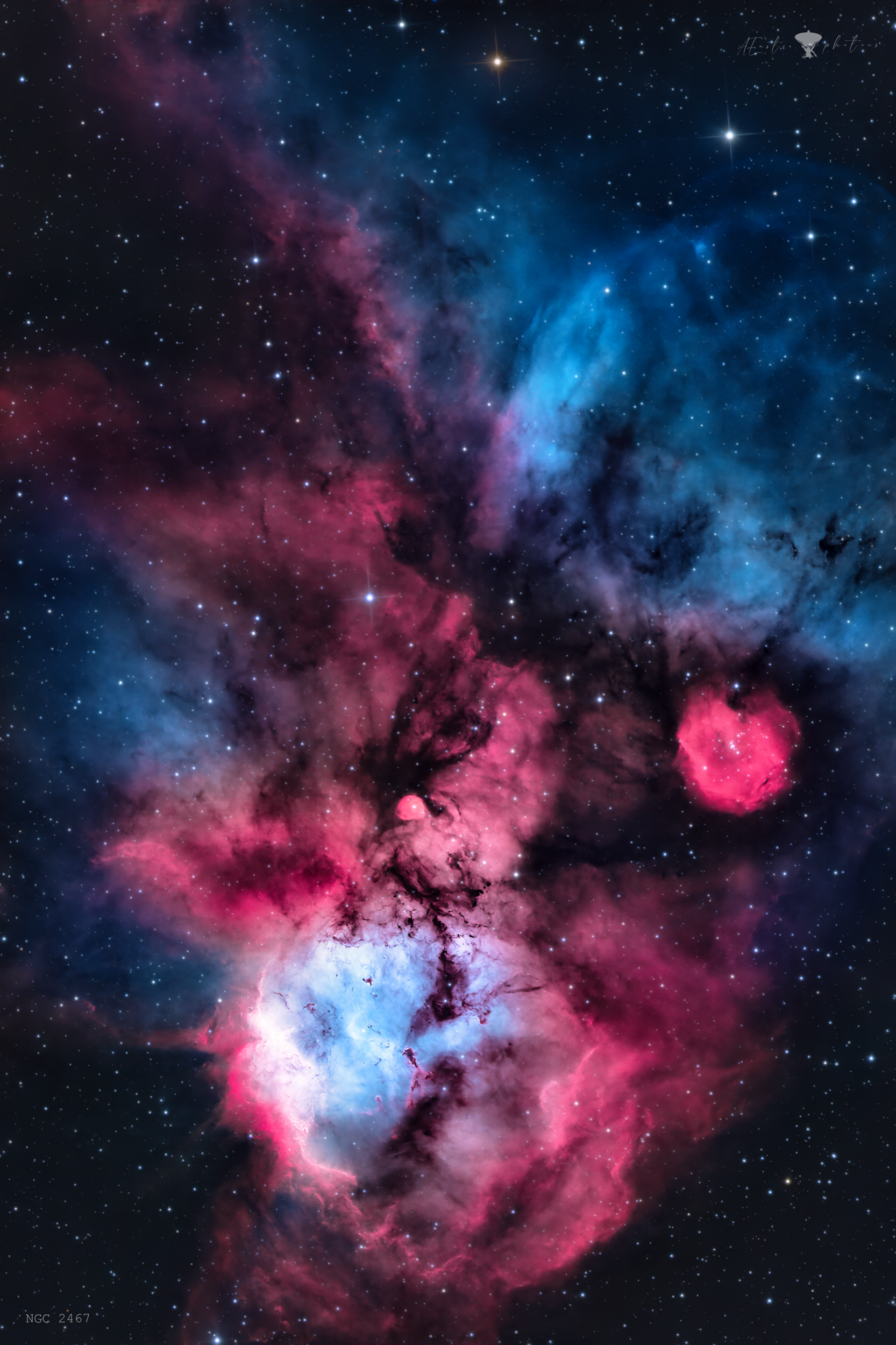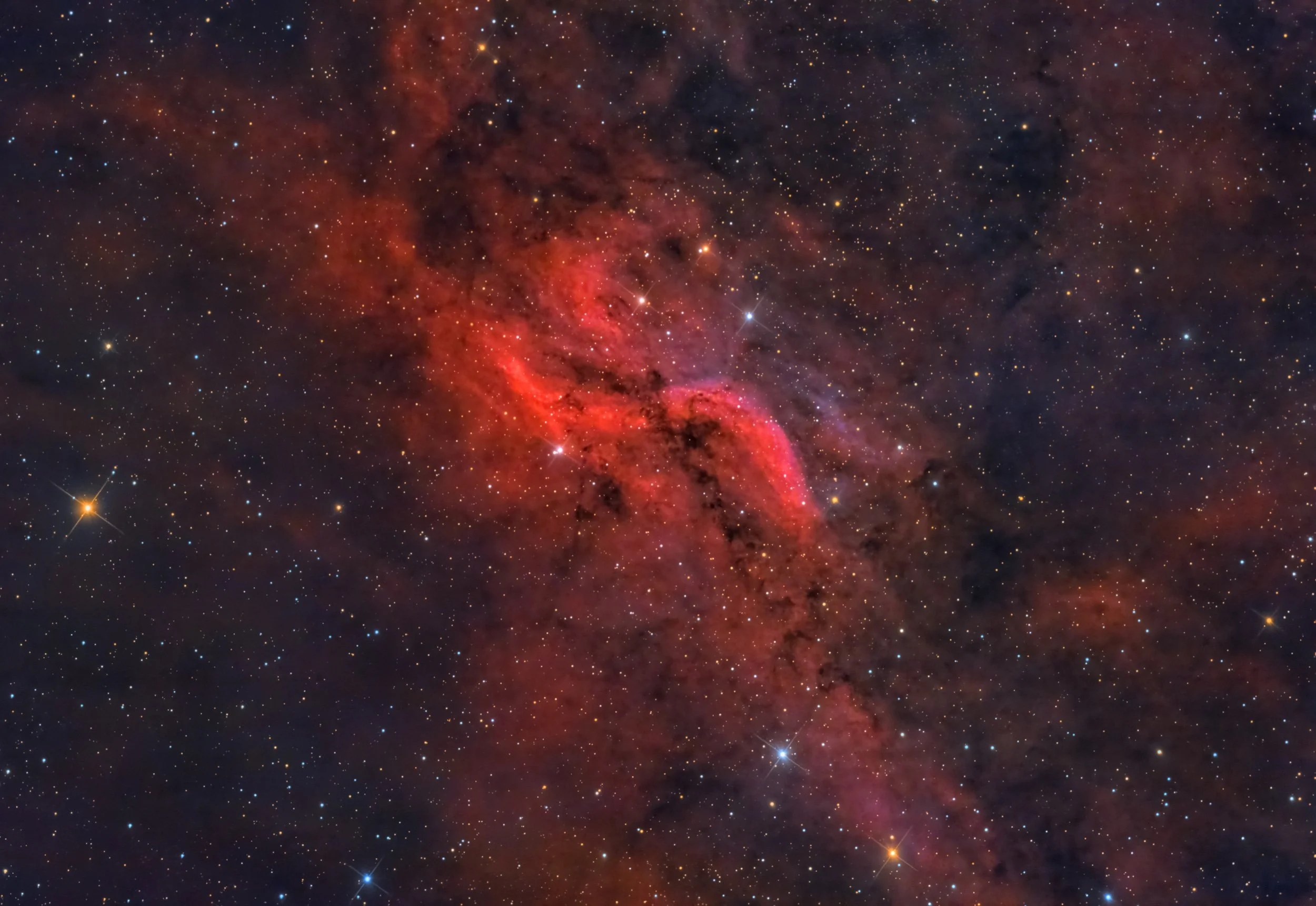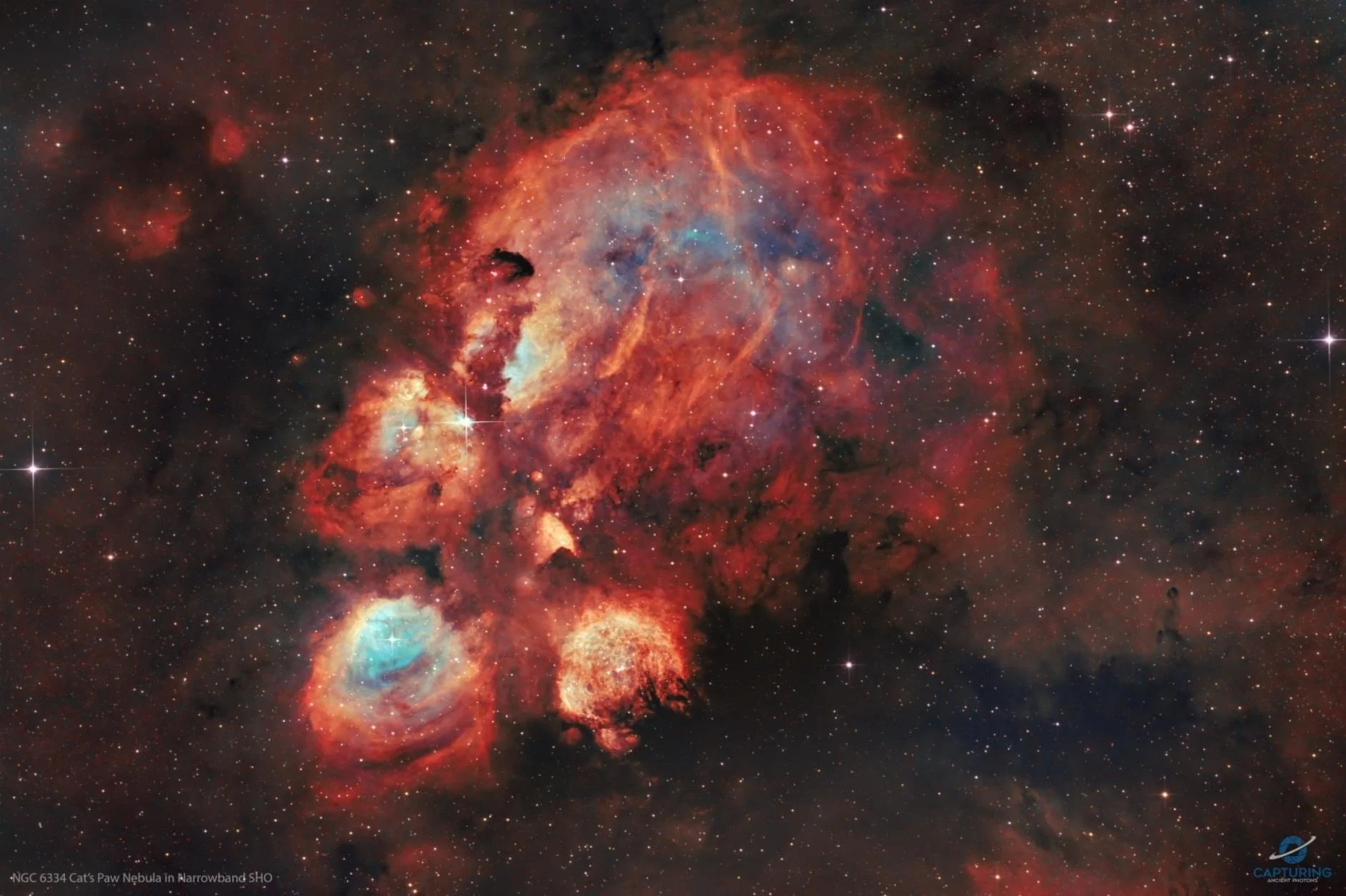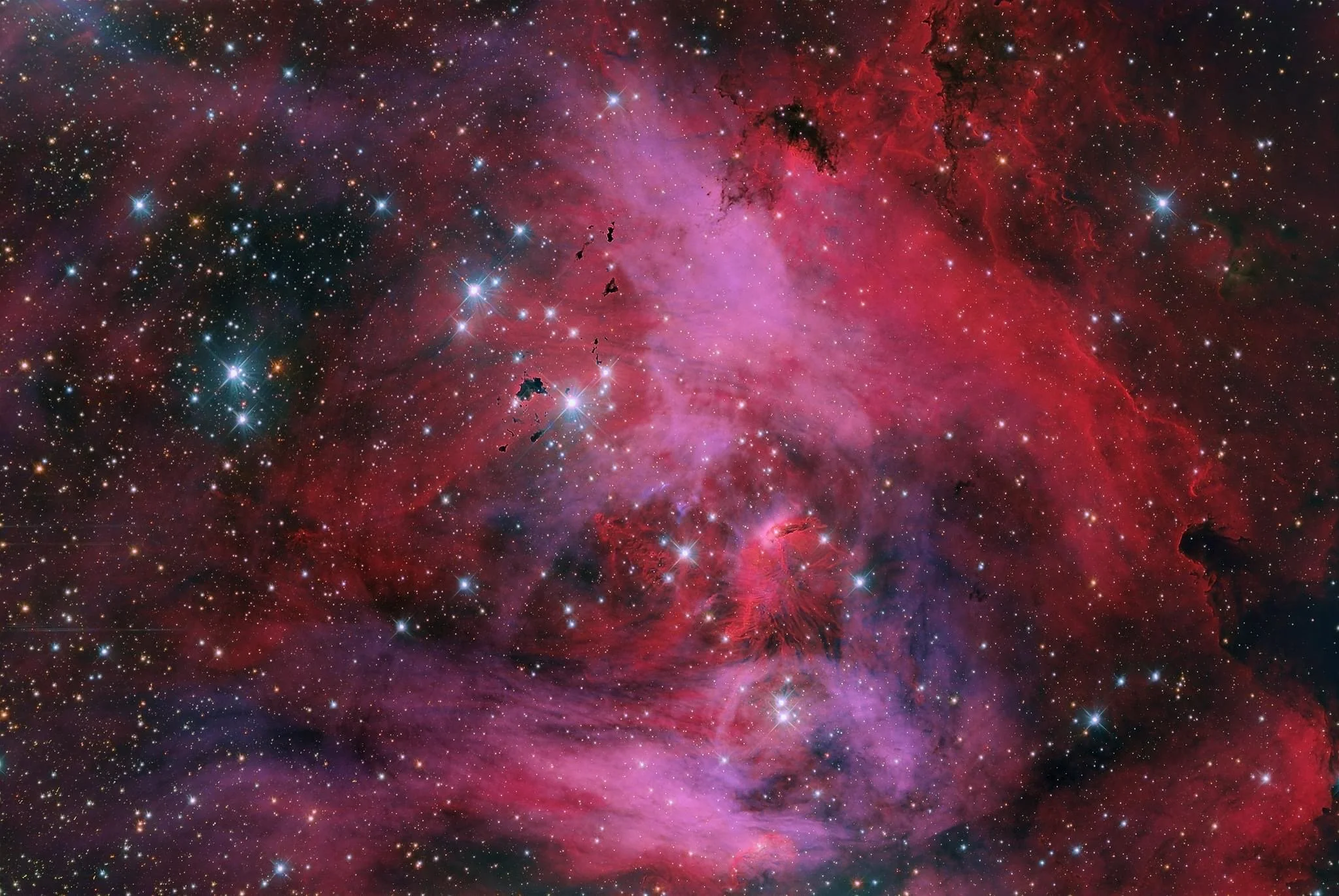
AAPOD2 Image Archives
W63 (SNR G082.2+05.3) in Cygnus
Image Description and Details : W63 (SNR G082.2+05.3) is a faint Supernova Reamnant in the constellation of Cygnus.
On the top right part of the image we can find the planetary nebula NGC 6884 with an Oiii envelope very visible.On the very top right, we can find StDr 139.
Takahashi FSQ-106EDX4
ZWO ASI2600MM
ProSky-Watcher EQ6
ProAntlia LRGBHO 3nmHa: 159×600″(26h 30′)
Oiii: 131×600″(21h 50′)
R: 20×180″(1h)
G: 20×180″(1h)
B: 20×180″(1h)
Clear skies
Copyright: Team Atlaskies
Ngc6888 and Soap Bubble
Image Description and Details : NGC 6888 Crescent nebula and Soap Bubble
Tecnosky APO Triplet 115/800
Omegon veTec 571 M
iOptron CEM70G
Filters
Optolong Blue 2" Optolong Green 2" Optolong H-Alpha 3nm 2" Optolong Luminance 2" Optolong OIII 3nm 2" Optolong Red 2" Optolong SII 3nm 2"
Accessories
Primaluce Lab SESTO SENSO 2 WandererAstro WandererBox Ultimate V2 WandererAstro WandererCover V3 WandererAstro WandererRotator Mini
Software
Adobe Photoshop Han K. Astrometric STAcking Program (ASTAP) iOptron ASCOM Driver and Commander Pleiades Astrophoto PixInsight Stark Labs PHD Guiding Stefan Berg Nighttime Imaging 'N' Astronomy (N.I.N.A. / NINA)
Guide telescopes and cameras
Omega 90/500
Omegon veLOX 224 C
poses:
Optolong Blue 2": 19×300″(1h 35′)
Optolong Green 2": 19×300″(1h 35′)
Optolong H-Alpha 3nm 2": 26×600″(4h 20′)
Optolong Luminance 2": 31×300″(2h 35′)
Optolong OIII 3nm 2": 23×600″(3h 50′)
Optolong Red 2": 19×300″(1h 35′)
Integration:
15h 30′
Copyright: Luca Dinoi
Dragon Egg Nebula
NGC 6164 (sometimes referred to as the Dragon Egg) is a bipolar emission nebula spanning around 4 light-years across. It is situated 4,200 light-years away in Norma.
Its symmetric gaseous shroud and faint halo surround the blue, young, central star HD 148937, the brightest member of a triple star system orbiting around each other, from which powerful stellar winds moving around 8 million kilometers per hour created the nebula.
The hot, luminous O-type star is some 40 times more massive than the Sun and only 3 to 4 million years old. In another 3 to 4 million years the massive star will end its life in a supernova explosion.
NGC 6164’s bipolar symmetry, as well as its extensive halo makes it similar in appearance to a planetary nebula but it is not. Expanding into the surrounding interstellar region the material in the halo is probably from an earlier gas burst from the central star, about 4000 years ago.
Imaged in Ha OIII and RGB on our Planewave CDK 700 at Observatorio El Sauce, Chile.
Image Processing: Mike Selby
Unnamed nebula near NGC 6250
Years ago I did NGC 6250 with 12" scope, now just recently I looked at this image and saw that there is a quite interresting nebula just a few arcminutes from the open cluster.
I did this one with the 24" last night just as a test to see if it is really interresting.
The exposure time was a rather short LRGB 60 45 45 45 min.
Copyright: Wolfgang Promper
M8
Image Description and Details :
It is a core of M8 Lagoon Nebula, which was acquired during 11 nights of the month of May, from Maringá Brasil.
Obtained with a
Telescope Stellarvue 80 ED Raptor
Filter SHO - Astronomik 12nm
Camera ASI294mm Pro
Mount Sky Watcher Neq6
Capture N.I.N.A.
Processing Pixinsight - Topaz
Sky Bortle 6
It has a total of 15hs 32min for acquisition, but I selected between the best 21hours of exposure.
From Maringa Brazil
When I saw the result I saw that it looks like an ice lagoon surrounded by fire, hence the name I gave to this photo
Copyright: Marcelo G Salemme - Astromgs
Sh2-73
Image Description and Details : Sh2-73is located in the constellation Hercules and was mistakenly included in the Sharpless catalog as an emission nebula.We now know that the nebula is simply a molecular cloud. With its relatively high galactic latitude, about 45°, the integrated light of the galaxy illuminates the nebula.
Astrosib RC 20" + camera FLI Kepler 4040
Total RGB=28h15mn
The skyX + ccdautopilot + APP + Pixinsight +Photoshop
Form E-eye (Fregenal de la Sierra,Spain)
Copyright: Georges Chassaigne
M101 supernova
Cropped image of M101 image of last night, with bright supernova 2023ixf (discovered in Japan on May 19th). The supernova is indicated between two line segments. The sky was not really good, with high thin clouds present during the 2 hour exposure with Takahashi Epsilon 160ED.
Copyright: Dominique Dierick
M24
Image Description and Details : M24, also known as the Small Sagittarius Star Cloud, is a large star cloud in the constellation of Sagittarius. It is located about 10,000 light-years from Earth and has an apparent magnitude of 4.6. M24 is about 600 light-years wide and lies in the Sagittarius Arm of our galaxy, the next inner spiral arm to our own.
The star cloud is visible to the naked eye as a large, hazy patch in the Milky Way. Binoculars and small telescopes reveal a dense concentration of stars, including many young, bright stars. M24 is also home to a number of open clusters, including NGC 6603.
The physical composition of M24 is dominated by hydrogen and helium, with trace amounts of other elements. The average temperature of the gas in M24 is about 10,000 degrees Kelvin. The stars in M24 are mostly young and hot, with a few older, cooler stars. The open clusters in M24 are about 100 million years old. A detailed examination of the image reveals the full life cycle of stars. Supernova remnants, gas clouds, and condensing dark nebulae are scattered across this narrowband vista, providing a glimpse into the birth, life, and death of stars.
Tech:
Takahashi FSQ @ f/5
FLI Proline 16803
5nm Ha and OIII filters
10 x 1800s exposure each color channel. Ha assigned to red. OIII assigned to blue
MaximDL, Astro Pixel Processor, Croman StarX, Photoshop
Coonabarabran, NSW, AUS
Copyright John P. Gleason
NGC 2467 - Skull and Crossbones Nebula
Image Description and Details :
Known as the "Skull and Crossbones Nebula", NGC 2467 is an extremely active stellar nursery that glows in deep reddish tones and is located within the constellation Puppis. Numerous stars and clusters come together to make this stunning stellar portrait. Among numerous gems in the region, dust lanes and dark globules mark sites of future star formation. One of the most notable clusters within NGC 2467, known as Haffner 18, houses around 50 stars. The NGC 2467 complex lies about 17,000 light-years away.
Photographed in narrowband emission (H-alpha & O-3) at El Sauce Observatory, Rio Hurtado, Chile, during May 2023.
Clear skies,
A.
Copyright: @ae_astrophotons
Scope: Planewave CDK 24”
Filters: H-alpha & O-3
Integration: 5h
Country: El Sauce Observatory, Rio Hurtado, Chile (T-Live)
Date: May 2023
Copyright: Copyright: @ae_astrophotons
Iss
Image Description and Details : I took this Picture from the ISS on May the 19. at 0h29m04s MESZ from my Balkony in Hamm / Western Germany / Ruhrgebiet.
My Teleskop was an Explore Scientific 10 Inch Dobson with f/5
The Camera was a Asi 178mm with a cheap 2x Barlow
I once labeled a few parts of the ISS. I hope I got it right.
Copyright: Jörg Ortmann
Propeller Nebula
Image Description and Details : The Propeller nebula (also known as DWB 111 or Simeis 57) is a emission H-alfa nebula in Cygnus constellation in the center of a triangle made by Deneb, Sadr and Delta-Cyg.
DWB and Simies designations are not so commonly known. The Simeis Catalog was created in the 1950s by the Crimean Astrophysical Observatory in Simeis, Ukraine. This catalog is focused on HII regions and documented 306 of them. The Propeller Nebula is item 57 in this catalog.
The DWB catalog was created in the 1960s by H. R. Dickel, H. Wendker, and J. H. Bieritz, and it cataloged the HII regions they were studying in the Cygnus X Complex. While DWB 111 is often used as the designation for the Propeller, it only deals with the southern arm of the Propeller, while DWB 119 deals with the northern arm. So you can call the Propeller Nebula DWB 111/119 or Semeis 57.
Konus 200/1000 @960mm, f/4.8
Qhy168c @-5 °C
Sky-Watcher Eq6r Pro mount
Optolong L_Ultimate 126x300" (gain 11, offset 60)
SvBony UV/IR-cut 161x30 (gain 1, offset 30)
N.I.N.A., DSS, APP, PixInsight, PS
Copyright: Massimo Di Fusco
Ngc. 6334
NGC 6334 is an ionized hydrogen-rich emission nebula and star-forming region more commonly known as the Cat's Paw nebula. It lies in the constellation Scorpius and is around 5,500 light-years from Earth and 50 light-years across.
94 x 300s SHO subs shot @0C spread across 3 nights for a total integration time of about 8 hrs.
Equipment used:
Skywatcher 10" f4 Newtonian 250P
Skywatcher F4 Aplanatic Coma Corrector
Skywatcher NEQ6 Pro Hypertuned by Astronomy Academy Perth
ZWO ASI2600MM Pro Cooled Camera
Primaluce Sesto Senso2 Electronic Focuser
William Optics Uniguide 50/200mm guidescope
ZWO ASI290MM Mini Guide Camera
ZWO Electronic Filter Wheel
Antlia Pro 36mm unmounted filters
Rollon rolloff modified shed observatory
Bortle 5
Data acquisition software: NINA Astronomy Software
Processing software: PixInsight and Photoshop CC
Copyright: Capturing Ancient Photons
Sh2-173 | Phantom of the Opera
Image Description and Details : Hardware
Lacerta Fotonewton 200/800 (pre-2021)
QHYCCD QHY268 Pro C · ZWO ASI1600MM Pro
Sky-Watcher EQ6-R Pro
Astronomik H-alpha CCD 6nm 1.25" · Astronomik L-2 Luminance UV/IR Block 2"
Lacerta MFOC Motorfocus · Lacerta MGEN-3 standalone autoguider
Frames:
Astronomik H-alpha CCD 6nm 1.25": 91×300″(7h 35′) (gain: 139.00) -15°C bin 1×1
Astronomik L-2 Luminance UV/IR Block 2": 98×300″(8h 10′) (gain: 0.00) -15°C bin 1×1
Software
Adobe Photoshop · Pleiades Astrophoto PixInsight · Russell Croman Astrophotography BlurXTerminator · Russell Croman Astrophotography NoiseXTerminator · Stefan Berg Nighttime Imaging 'N' Astronomy (N.I.N.A. / NINA)
Copyright: Jan Schubert
The Molecular Nebula in Corona Australe
Image description:
Taken with ZWO ASI 2600 MC and Fsq 106 on AP 1200 mount, 21 x300 gain 0, from Tivoli Farm, Namibia 🇳🇦, April 2023
Copyright: Alessandro Bares
M 82 Cigar Galaxy
Messier 82 was discovered in 1774 by Johann Elert Bode, rediscovered by Pierre Mechain August 1779 who reported them to Charles Messier, who added them to his catalog in 1781.
M 82 is the prototype irregular starburst disk galaxy. In the core of M 82, the active starburst region spans a diameter of 500 parsecs.
Tendrils of material extend away from the nucleus, suggesting a colossal explosion. Studies have revealed filaments expanding outward from M 82 at 600 miles per second.
Imaged over 5 nights from my home in Gérgal, Spain.
Technical summary:
Captured: 26,27,28-02-2023 & 02,03-03-2023
Imaging Sessions: 5
Location: Gérgal, Andalucía, Spain
Bortle Class: 4
Total Integration: 32h 28m
Filters:
Red 349x 60s 5h 49m BIN 3 Gain 100 -5C SQM 20.7
Green 300x 60s 5h 00m BIN 3 Gain 100 -5C SQM 20.7
Blue 300x 60s 5h 00m BIN 3 Gain 100 -5C SQM 20.7
UV/IR 484x 60s 8h 04m BIN 3 Gain 100 -5C SQM 20.7
Ha 103x 300s 8h 35m BIN 3 Gain 100 -5C SQM 20.7
Pixel Scale: 0.33 arcsec/pixel
Telescope: Celestron C11 Edge HD 2800mm fl
Image Camera: ZWO ASI 6200MM Pro
Guiding: ZWO OAG L with ZWO ASI 192MM Mini
Filters: Astronomik R, G, B, UV/IR, Ha
Mount: Skywatcher EQ6R Pro
Computer: Minix NUC
Capture software: NINA, PHD2
Processing Software: PixInsight, Adobe Lightroom
copyright: Eric Smith
Lacus Veris, Lacus Autumni, Schluter and Montes
Image Description and Details : During May 6 2023 i imaged the Lacus Veris Lacus Autumni Schluter and the Montes on the lunar limb as in previous image. The region into account was selected and studied for identification of the features here enclosed and compared with WAC LRO imagery. some peaks of this region were identified, according to the work of Vandenbohede (J. Br. Astron. Assoc. 132, 2, 2022). The location is shown based on favourable libration.
Copyright: Raffaello Lena
Ic2948
IC 2948 - The Heart of the Running Chicken Nebula.
Hello everyone, we reached the middle of the week and I am going to leave here this image of another object located in the southern hemisphere and that I finished yesterday, I hope you like it and you all have a very good day.
The image covers IC 2948 and part of IC 2944, it is located in the constellation of Centaurus, very close to the star λ Centauri.
IC 2948 is the brightest emission and reflection nebula, located within the nebula but to the southeast of the Running Chicken Nebula. IC 2948 harbors several Bok globules, although this time here called Thackeray globules in honor of their discoverer, these globules made of dust and gas are places where active star formation usually occurs.
It is separated from us by approximately 6,500 light years.
Technical details:
Telescope: Quasar 12.5" f/9 Ritchey-Chretien Mount: Losmandy Titan Camera: SBIG STL11000 Set Filtros Ha, OIII, y LRGB. Datos: Luminancia : 43x600" -15C bin 1x1 Blue: 25x600" -15C bin 1x1 Green: 33x600" -15C bin 1x1 Red: 41x600" -15C bin 1x1 Ha: 80x600" -15C bin 1x1 OIII: 73x600" -15C bin 1x1 Tiempo de integración total: 48,7 horas.
Cooyright: Alberto Pissabarro


